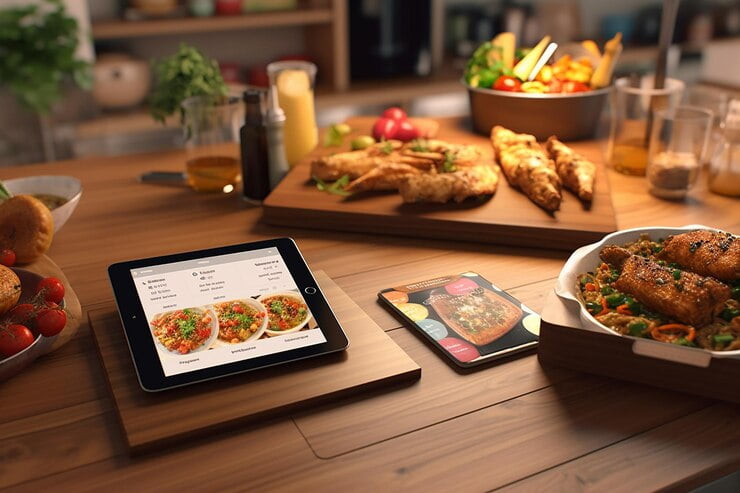In the relatively dynamic business of food services, digitalization has emerged as the key driver of change. Among the most significant changes, it is possible to mention the use of digital screens for ordering the food. These screens, used in fast foods, cafes, and even in full-service restaurants, are revolutionizing the way people get to engage with their food. They include convenience, speed and improved accuracy, hence improving the satisfaction level of the customers and the operations. So, let’s take a closer look at why these digital ordering systems are disrupting the food industry.
1. Enhanced Customer Experience
Customers can spend as much time as they wish reading the menu displayed on the digital screen; they are able to order without being pressured. Standardized pictures and descriptions make it easier for the customers to determine what they are buying. Moreover, the options related to dietary preferences, allergies, and customization are easily seen and therefore, there is less chance of misunderstanding.
Digital kiosks can also be multilingual because they can have an option for the customer to select the language of their preference and this makes it personal.
2. Reduced Wait Time & Improved Efficiency
Another advantage of such digital screen for food ordering is that they are very efficient. Rather than stand in a long queue to order food, customers can go to a kiosk and order what they want and then go and pick it when it is ready. In some instances, restaurants have also incorporated mobile order and pay to where customers just confirm on a digital screen upon entering the restaurant.
This not only increases the rate at which services are delivered but also helps in the reduction of traffic flow during rush hours hence making the ordering process efficient.
3. Order Accuracy and Customization
Both written and verbal orders that are traditional in the clinical setting are not fully immune to errors. It is easy to make a mistake whether it is a misunderstanding of a request or forgetting an item. Digital screens eliminate this margin of error by enabling customers to order for themselves directly. Customization is also easier to achieve – a customer can add more toppings, remove certain components, or adjust the serving size, among others, with only a few clicks.
This enhances the quality of the dining experience that the customer receives as well as decreasing the wastage that is experienced by the restaurant.
4. Labor Cost Reduction
The use of digital screens could also help restaurants in cutting down on their staff expenses. Since ordering is automated, fewer employees are needed to take orders and this frees other employees to work on customer service, food preparation, and other pertinent tasks needed to maintain a high-quality dining experience.
It does not signify that human staff will be eliminated completely—there is always a demand for warm and polite personnel in any food industry. However, by moving staff back to be more productive and perform more value-added work, then both productivity and customer satisfaction will increase.
5. Upselling and Cross-Selling Opportunities
Digital screen for food ordering have one major selling point, namely that they can be used to upsell and cross-sell proficiently. Digital ordering systems allow for order upselling such as offering drinks or dessert based on the customer’s order. This is also possible by use of picture galleries and specific time offers which can be used to guide the customers to add more items to their carts.
For instance, a user that selects a burger may be offered a pop-up message notifying of an option to add fries and a beverage to the order and make it a combo. It also helps to raise the average order value, as well as providing a more interesting way to engage with the menu.
6. Data-Driven Insights
Digital ordering systems help to gather significant information about customer preferences, time periods when orders are made most frequently, and what menu items are most popular. The data can be used by restaurants to improve their business operations by changing the menu, hiring more workers during peak hours, and redesigning their marketing strategies.
Customer behavior analysis enables restaurants to adapt and respond to the needs of the consumers effectively.
7. Contactless Ordering and Payments
One of the challenges that was exacerbated by the COVID-19 pandemic is contactless ordering. Digital ordering systems are safer and more hygienic, reducing the contact between customers and service providers. The screen allows customers to order and even make payments, thus eliminating contact with the cash or cashier. This is not only convenient but also helps customers to be comfortable with their safety when taking foods.
8. Branding and Customization
The other advantage of using digital screens is that restaurants can also have them designed to suit their branding. These screens are also an opportunity to convey the restaurant’s image: showing its logo, using specific colors and fonts. In addition, restaurants can change menu and promotion information instantly without having to reprint any materials, which provides more flexibility and less expense.
Digital screens for food ordering are gradually making their way into the market as they are convenient, efficient and satisfying customers. This means that more restaurants will implement this solution as the market advances to a state where speed, accuracy, and personalization are becoming more important. It’s a no brainer to integrate online ordering whether you are a fast-food joint or a high-end restaurant since it will lead to increased sales, less expenses and definitely happy customers.
Digital ordering screens are the best way to go in a world that is fast moving and does not have the time to wait on waiters.





